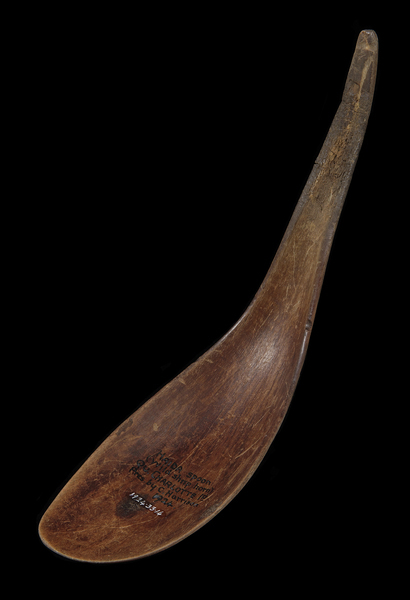Spoon Item Number: 1924.33.14 from the Pitt Rivers Museum

Description
Plain spoon made of horn. [CAK 17/05/2010]
Longer Description
Plain spoon made of horn. The spoon is smooth. The handle tapers toward the tip. The bowl is relatively shallow, and the angle between the bowl and handle is minimal. The horn is brown in appearance. [CAK 17/05/2010]
Primary Documentation
Accession book entry - C. HARRISON, Esq. Specimens collected from the HAIDA of QUEEN CHARLOTTE ID., B.C.... - [1 of] 2 Large spoons made from mountain-sheep's horns
No additional information on catalogue cards. [JC 5 9 1996]
Written on object - HAIDA spoon (wild sheep horn) QU. CHARLOTTE ID. Pres. by C. Harrison 1924. [El.B 'DCF 2004-2006 What's Upstairs?' 17/3/2006]
Related Documents File - The Haida Project Related Documents File contains video of research sessions and interviews with Haida delegates from September 2009 as part of the project ‘Haida Material Culture in British Museums: Generating New Forms of Knowledge'. It also includes post-visit communications that discuss object provenance. For extensive photographic, video, and textual records documenting the Haida research visit as a whole, including but not limited to preparations of objects for handling, travel logistics, British Museum participation, transcribed notes from research sessions and associated public events held at PRM, see the Haida Project Digital Archive, stored with the Accessions Registers. Original hand-written notes taken during research sessions have been accessioned into the Manuscripts collection, in addition to select other materials. [CAK 02/06/2010]
Research Notes
The following information comes from Haida delegates who worked with the museum's collection in September 2009 as part of the project “Haida Material Culture in British Museums: Generating New Forms of Knowledge”:
This spoon was viewed alongside other horn and wooden spoons on Wednesday Sept 9, 2009. Delegates commented on the fine grain of the horn and the signs of wear, warping and aging. They commented that the spoon looked burnt on the bottom and wondered if this was because it was left near a fire. They wondered if it was salvaged, or collected from a cave. The sheep was identified as Dall sheep because of the lighter colour.
The spoons as a collection elicited a lot of discussion amongst delegates. They discussed whether the different varieties of spoons reflected differences in the owner's rank, or differences in function (i.e. everyday use vs. use at a feast). It was thought that the plain spoons (i.e. those collected by Charles Harrison, 1891.49.50- .51) were for everyday use. Delegates were also interested in the greenish hue of many of the spoons and this was identified as unusual. One delegate offered that, in general, mountain goat horn was used for smaller spoons because they have a narrower shape to their horns. People noted that the shape of a spoon can be altered by heat (i.e. from the soup itself). [CAK 17/05/2010]
Item History
- Made in British Columbia Haida Gwaii NW Coast, Canada
- Collected by Charles Harrison
- Owned by Charles Harrison
- Received from Charles Harrison during 1924
What
- Name
- Spoon
- Identification Number
- 1924.33.14
- Type of Item
- spoon
- Material
- sheep horn
- Manufacturing Technique
- steamed, moulded and carved
- Overall
- length 262.0 mm
Who
- Culture
- Haida
- Field Collector
- Charles Harrison
- Previous Owner
- Charles Harrison
- Received from
- Charles Harrison
Where
- Holding Institution
- Pitt Rivers Museum
- Made in
- British Columbia Haida Gwaii NW Coast, Canada
When
- Acquisition Date
- during 1924
Other
- Keyword
- Spoon; Food Accessory; Status Object
- Class
- Food; Status